The Kitsons of Leeds
by Bryan Matthews
The most interesting of the families on my side are undoubtedly the Kitsons, because in their intricate relationships they are an excellent example of the general economic and social progress of 19th century England.
My Mother was born on 10th April l873 and christened Annette Amelia. I have often thought that for a girl to be saddled with two such names she could only have been born in the last few decades of the 19th century; but she was generally known as Netty, until she grew to the later Edwardian dignity of “Aunt Annette”. She was the fifteenth child of a very remarkable man indeed, who not only founded a vast family in true Victorian style, and a large industrial empire, but also became the first Citizen of Leeds, purchased a large estate and left an heir who was raised to the peerage as Lord Airedale, and became a personal friend of Mr.Gladstone.
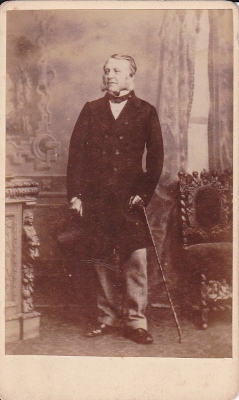 The founder of all this prosperity and importance was JAMES KITSON, typical of a Victorian self-educated, self-made, highly religious entrepreneur. He was born in 1807, two years after the Battle of Trafalgar, in Leeds where his parents kept a Public House. I will not interrupt the narrative here to relate his more detailed provenance. It is sufficient here to point out that although he was not born in grinding poverty, he certainly came from humble beginnings. By the age of 30 he was making a name for himself in Leeds and was becoming known in the lower-middle-class mechanics level of Society. He was a handsome man with some presence and a fine singing voice. My Mother could remember him, even in his old age rolling out the choruses and bass arias from the Messiah which of course every Yorkshireman learnt at an early age. More importantly he clearly had great business acumen and made his fortune from taking the right decision at just the right time. He built up in the dank, low-lying valley of the River Aire (which had recently been canalised) a foundry and works to manufacture locomotives, just at the moment when the Railway Age was creating a mass demand for them. This must have been in the 1830’s and l84O’s.
The founder of all this prosperity and importance was JAMES KITSON, typical of a Victorian self-educated, self-made, highly religious entrepreneur. He was born in 1807, two years after the Battle of Trafalgar, in Leeds where his parents kept a Public House. I will not interrupt the narrative here to relate his more detailed provenance. It is sufficient here to point out that although he was not born in grinding poverty, he certainly came from humble beginnings. By the age of 30 he was making a name for himself in Leeds and was becoming known in the lower-middle-class mechanics level of Society. He was a handsome man with some presence and a fine singing voice. My Mother could remember him, even in his old age rolling out the choruses and bass arias from the Messiah which of course every Yorkshireman learnt at an early age. More importantly he clearly had great business acumen and made his fortune from taking the right decision at just the right time. He built up in the dank, low-lying valley of the River Aire (which had recently been canalised) a foundry and works to manufacture locomotives, just at the moment when the Railway Age was creating a mass demand for them. This must have been in the 1830’s and l84O’s.
Just before World War 2 there was a famous film made with Anna Neagle as Queen Victoria and Anton Walbrook as Prince Albert. In this film there was a comic episode when the Queen’s Coachman insisted on riding on top of the railway engine when she and Albert made their first journey by train, - and as a result the coachman became drenched: with soot from the funnel. Now the early engine used in the film (resurrected from some museum) had been made in the ear1y l84O’s by James Kitson, when he must have been in his mid-thirties.
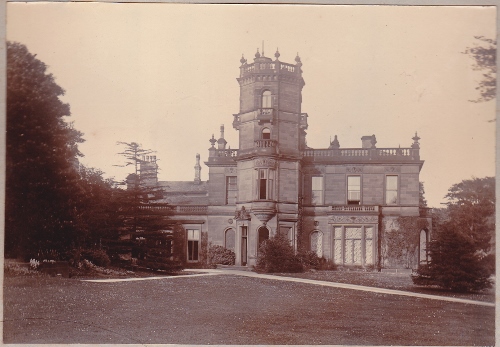 James Kitson’s fortune must have burgeoned in the prosperous mid-Victorian period until, in the 1860’s, he was able to buy a large early 19th-century house on the smart outskirts of Leeds with grounds around it. This was and is still called ELMET HALL, (sometimes called Elmete), named after the part of Yorkshire in which it lies. I have visited it twice, once when it was empty and desolate; once later when it had been bought by the City Council and turned into a Home for deaf chi1dren and a Secondary Modern School, all modern and glassy, had been built in the park below. The house stands on a brow above the Roundhay or Wetherby Road, and the “Park” as my Mother used to call it, stretched down from the house, and must in its time have been a fine approach. But I thought it did not quite warrant the name of a Park, especially as it lies next to a much more magnificent park called “Roundhay Park” which has been taken over by the City Council as a public area.
James Kitson’s fortune must have burgeoned in the prosperous mid-Victorian period until, in the 1860’s, he was able to buy a large early 19th-century house on the smart outskirts of Leeds with grounds around it. This was and is still called ELMET HALL, (sometimes called Elmete), named after the part of Yorkshire in which it lies. I have visited it twice, once when it was empty and desolate; once later when it had been bought by the City Council and turned into a Home for deaf chi1dren and a Secondary Modern School, all modern and glassy, had been built in the park below. The house stands on a brow above the Roundhay or Wetherby Road, and the “Park” as my Mother used to call it, stretched down from the house, and must in its time have been a fine approach. But I thought it did not quite warrant the name of a Park, especially as it lies next to a much more magnificent park called “Roundhay Park” which has been taken over by the City Council as a public area.
When I first saw Elmet Hall (and wrote a letter describing it to my Mother) I was much taken by its decayed magnificence. I think it would be best to quote from the letter (written in August 1948) how I felt at the time: “I went first to the church at the bottom of the park, where I met an old grave-mender who could remember Hawthorn Kitson having the paths repaired. I was struck by the fantastic number of grave-stones, some of them large and vulgar erections, but it did surprise me that there were so close together. I saw the Kitson family graves - not as many as I had expected, - and the lettering on them is still legible though I doubt if it will last another 40 years or so.
From there I went up the meadow (the Park) which must look very like as you knew it. The trees are still inviolate and very handsome, but the drive is all overgrown and can only be distinguished by its flatness in the surrounding grass. Beyond the ha-ha there is desolation where the main lawn must have been and the house looks sad in its untidiness. During the War the army had it, and you know enough of army-occupied houses to realise the amount of mess they leave. However, it looked imposing in the sun, though I was horrified by the back-areas. I then plunged towards the gardens and having fought my way through brambles and willow-herb higher than my head, I came across what must have been the greenhouses and potting sheds. There I met a man, about 60 years old, to whom I explained my mission. He was at once very interested, for, though quite a newcomer, he had heard of the Kitsons. He had the keys of the house and after showing me the stables and the kitchen garden (which he was cultivating for the Corporation) took me right through the house. It was in a sorry mess, though intact, but they had taken the trouble to cover up the veneered doors and parts of the panelling. I was particularly impressed by the winding staircase up the central hall, and by the glorious resonance of it, so that one’s voice re-echoed in an operatic sort of way, - and secondly by the panelling and the staircase at the other end of the house. My word! What a lot of money must have been spent on it, and of what fine quality the things were. The glass in the windows is ¼ inch thick. My guide showed me the view over Roundhay Park and the golf- links on the edge, and the little summer-houses which overlook them. Then I walked down the drive-that-was and found I couldn’t get out through the iron gates, which did not, for some lucky reason, go for salvage in the War.
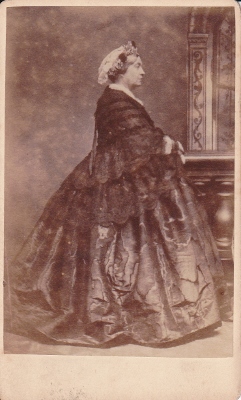 James Kitson’s virility was as remarkable as his other attributes. He married first at the age of 22, Ann Newton, who survived until 1865 in spite of producing 11 children in 20 years. Their first child, Frederick, was born in 1829, 44 years before my Mother who was James Kitson’s last child by a second wife. My Mother gave me a description of her eldest half-brother who was, she said, thoroughly Yorkshire in speech and manner, and was put at an early age to work at the Monkbridge Foundry which his Father had started in Airedale. It seems important that Frederick was a very skilled engineer who did much for the later development of the Airedale Works. From his branch of the family sprang many worthy and important citizens of Leeds, County Councillors and a Lord Mayor, and responsible for Timothy Kitson MP.
James Kitson’s virility was as remarkable as his other attributes. He married first at the age of 22, Ann Newton, who survived until 1865 in spite of producing 11 children in 20 years. Their first child, Frederick, was born in 1829, 44 years before my Mother who was James Kitson’s last child by a second wife. My Mother gave me a description of her eldest half-brother who was, she said, thoroughly Yorkshire in speech and manner, and was put at an early age to work at the Monkbridge Foundry which his Father had started in Airedale. It seems important that Frederick was a very skilled engineer who did much for the later development of the Airedale Works. From his branch of the family sprang many worthy and important citizens of Leeds, County Councillors and a Lord Mayor, and responsible for Timothy Kitson MP.
The second child of James and Ann Kitson, called Ann, was born in 1830 but died at the age of 6. There were then two Henrys, one of whom lasted a year and the other died on the day on which he was born. It was the fifth child, given his father’s name of James, who brought most lustre to the family. He became a Liberal Politician (while at the same time working at the Foundry in a managerial capacity), a friend of Gladstone, successively Sir James Kitson Bart., and then Lord Airedale. He was also the first LORD Mayor of Leeds, for when his father was first citizen, Leeds was not yet a City, and the father was simply Mayor. Lord Airedale died in 1911, and was well remembered by my Mother, who always called him “Brother James”.
The sixth child, Mary Ann, married into the intelligentsia, and her husband was Professor E.C.Clark, Regius Professor of Civil Law at Cambridge, and a Fellow of St. John’s College. They produced Edwin Kitson Clark, who wrote the history of the Kitson firm and who was the father of George Kitson Clark, Fellow of Trinity College, Cambridge, and until he died recently, a historian of note. Then, seventh, came Emily, born 1841, died 1917, who married Dr. William Playfair, one of the most eminent gynaecologists of his day, well-known to and employed by Queen Victoria for her grandchildren’s births, until he blotted his copy-book in the Arthur Kitson case. One of their children was Sir Nigel Playfair, a famous actor and impresario, who made his name by a famous revival of Gay’s “The Beggar’s Opera” in the early 1920’s. The 8th child is nameless in my records, and must have died in infancy.
The ninth was a boy, Hawthorn, who was born in 1843 and inherited Elmet when his father died, since the surviving elder brothers had all by then made their piles and lived in large mansions in other parts of Leeds. Hawthorn married a girl called Jessie Ellershaw, famous for her grand-piano legs which she donated to all her descendants.
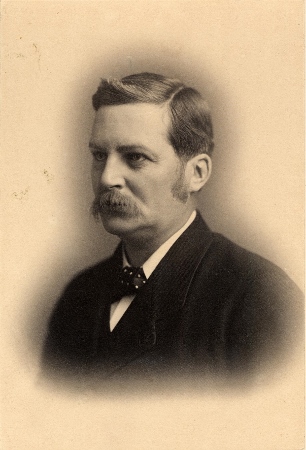
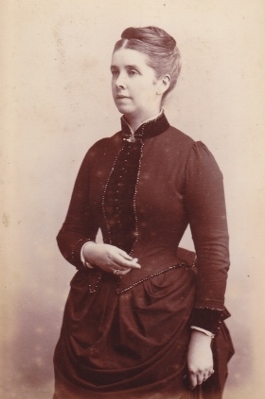 Hawthorn was employed at the Airedale Foundry from 1863, when he was 20, and was occupied in locomotive design. He is described as an odd and unreliable man, but a distinguished Alpine climber in the Whymper days. He was elected a member of the Alpine Club at the age of 24 (1867) but gave up climbing in 1876 after a severe illness, and he then became a specialist in Alpine flowers. After he had succeeded to Elmet (which was in 1885) he lived there until his death which occurred in 1899 when he was only 59. Mother told me that it was family tradition that he drank too much, and was found dead one Sunday morning when everyone else returned from church - with his hand on the whisky bottle.
Hawthorn was employed at the Airedale Foundry from 1863, when he was 20, and was occupied in locomotive design. He is described as an odd and unreliable man, but a distinguished Alpine climber in the Whymper days. He was elected a member of the Alpine Club at the age of 24 (1867) but gave up climbing in 1876 after a severe illness, and he then became a specialist in Alpine flowers. After he had succeeded to Elmet (which was in 1885) he lived there until his death which occurred in 1899 when he was only 59. Mother told me that it was family tradition that he drank too much, and was found dead one Sunday morning when everyone else returned from church - with his hand on the whisky bottle.
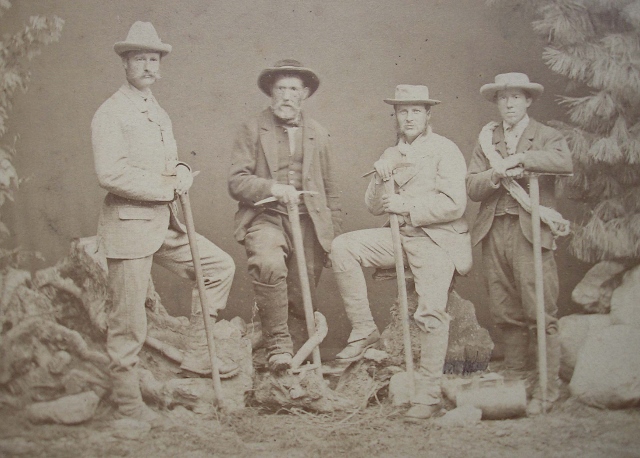 As Mother had a thing about drink and never missed a chance to point out its evils,I often wondered whether she had exaggerated this story, but Talbot Griffith’s letter to me of 30.12.73 shows that in fact Hawthorn died on Whitsunday, 21st May 1899. “He had been in the dining-room at noon....the footman found him lying on his face. He had evidently fallen flat on his face and the suffusion of blood caused a rupture”. It doesn’t say he was at the whisky bottle, but he was known in the family as “Old Whisky”, and looks as if he had a stroke when going to the tantalus. After his death, his elder brother, Lord Airedale, wrote to Emily, his own daughter, as follows:
As Mother had a thing about drink and never missed a chance to point out its evils,I often wondered whether she had exaggerated this story, but Talbot Griffith’s letter to me of 30.12.73 shows that in fact Hawthorn died on Whitsunday, 21st May 1899. “He had been in the dining-room at noon....the footman found him lying on his face. He had evidently fallen flat on his face and the suffusion of blood caused a rupture”. It doesn’t say he was at the whisky bottle, but he was known in the family as “Old Whisky”, and looks as if he had a stroke when going to the tantalus. After his death, his elder brother, Lord Airedale, wrote to Emily, his own daughter, as follows:
“A sad end to what ought to have been a noble life. He had intellectual powers of a high order, but he did not show the best results. Some strain or other, we cannot know how, directed his mind into action which darkened his career.”
This is maddeningly obscure, but I find myself in the end with the conclusion that Hawthorn had a drink problem.
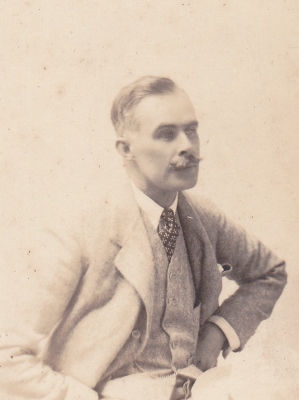 I came to know in my early life some of Hawthorn’s offspring quite well. The eldest son was my Uncle Robert, exactly the same age as my Mother, though a generation lower. He was a charming, gifted artist who spent most of his life in Taormina in Sicily painting. We have two of his paintings in this house - Kairouan in Tunisia and Benares in India, both painted during his many travels. He was supposed to be very delicate because his Nanny had doped him with opium when a baby to quell his cries. I remember he creaked like a semaphore whenever he moved and he had a marvellous chiming hunter-watch with which he used to entrance me as a child. He was adored in Taormina by the Sicilians, and always said he had to live in a warm climate for his health; but when Mussolini entered the War, Uncle Bob had to take refuge in England, but he nonetheless survived the very severe war winters of 1941 and 1942 and he returned to Taormina in 1945 where he was welcomed back like a hero. He died there a year or two later in his 70’s. His niece, Daphne Phelps ran his house as a bed and breakfast particularly for artists in more recent years. I have probably told you the story of how Uncle Tony (Major F.H.Tate of the Military Police) occupied his house in 1943 after the Germans had left Taormina, and sent Uncle Robert one of his own books. It is a 1ovely house, with classic views of the Mediterranean and Etna.
I came to know in my early life some of Hawthorn’s offspring quite well. The eldest son was my Uncle Robert, exactly the same age as my Mother, though a generation lower. He was a charming, gifted artist who spent most of his life in Taormina in Sicily painting. We have two of his paintings in this house - Kairouan in Tunisia and Benares in India, both painted during his many travels. He was supposed to be very delicate because his Nanny had doped him with opium when a baby to quell his cries. I remember he creaked like a semaphore whenever he moved and he had a marvellous chiming hunter-watch with which he used to entrance me as a child. He was adored in Taormina by the Sicilians, and always said he had to live in a warm climate for his health; but when Mussolini entered the War, Uncle Bob had to take refuge in England, but he nonetheless survived the very severe war winters of 1941 and 1942 and he returned to Taormina in 1945 where he was welcomed back like a hero. He died there a year or two later in his 70’s. His niece, Daphne Phelps ran his house as a bed and breakfast particularly for artists in more recent years. I have probably told you the story of how Uncle Tony (Major F.H.Tate of the Military Police) occupied his house in 1943 after the Germans had left Taormina, and sent Uncle Robert one of his own books. It is a 1ovely house, with classic views of the Mediterranean and Etna.
Uncle Robert’s sister, my Aunt Ethel, lived at Five Ashes in Sussex, and I got to know her son, Jack Phelps, well, as he was just my age. Aunt Ethel went to Newnham College at Cambridge before ladies were officially awarded degrees, and her son Jack was a Winchester scholar, then went to Trinity, Cambridge, won a place in the Indian Civil Service, and although he was only a year older than I, spent his first eight years in India more or less ruling a vast area in the Punjab. So short a time ago did the British Raj end.
James Kitson’s tenth child, Charles Henry, lived only two months in 1845 (you will have noticed how all the children christened Henry died young).
Then eleventh came the notorious “Black Sheep”, Arthur, born in 1848, the saga of whose life, exile to Australia and unhappy return to plague his elders, certainly deserves a special section in this history.
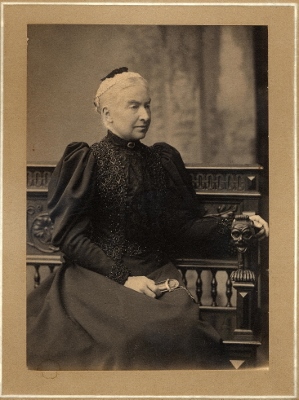 James Kitson and Ann Newton had no more children after 1848, and 20 years later, three years after Ann’s death, James married a second time at the age of 61. His second wife was a Miss Elizabeth Hutchinson, eldest daughter of a country clergyman. She was 35 years old and one must regard her marriage to one of the richest and most eminent of Leeds citizens as a considerable financial boost for her father’s rather penurious circumstances. Although he was over 60, James Kitson sired four more children, who were so much younger than his first family that they were a separate brood though as they grew up they had plenty of contact with the “once-removed” contemporary children of their older half-brothers and sisters. Mother always used to refer to “Brother James”, or “Brother Hawthorn”, both of whom were old enough to be her father, and indeed had children older than her.
James Kitson and Ann Newton had no more children after 1848, and 20 years later, three years after Ann’s death, James married a second time at the age of 61. His second wife was a Miss Elizabeth Hutchinson, eldest daughter of a country clergyman. She was 35 years old and one must regard her marriage to one of the richest and most eminent of Leeds citizens as a considerable financial boost for her father’s rather penurious circumstances. Although he was over 60, James Kitson sired four more children, who were so much younger than his first family that they were a separate brood though as they grew up they had plenty of contact with the “once-removed” contemporary children of their older half-brothers and sisters. Mother always used to refer to “Brother James”, or “Brother Hawthorn”, both of whom were old enough to be her father, and indeed had children older than her.
This new family of four remained pretty close, although the eldest, Reggie, died at the age of 27 of a brain tumour. The second child in this group was my Aunt Eva, who loomed large in my early years, physically and in the number of occasions I saw her. By then she was in her 60’s, much larger and fatter than my Mother, a dominant tyrant who had bullied my Mother relentlessly in their youth, and later bullied her mild-mannered husband. When I used to go and stay with them at Llys Bach, in Harlech, a house overlooking the castle, I witnessed her callous bullying of her by then semi-senile husband, the R Arthur Swayne. He had fallen in love with her while a curate near Scarborough and Mother told me how their maids had commented when the engagement was announced - “Oh, not Miss Eva, surely, it should have been Miss Netty”, for they thought Mother’s more timid temperament more suited to the quiet young curate. But I expect that Eva was the more attractive, vivacious, - and, no doubt, pushing. She was also later a golf addict, who ran the Ladies’ side of the Royal St. David’s Golf Club at Harlech for years, and a bridge fanatic whose post-mortems were terrifying. When I knew her she smoked about 50 “Passing Clouds” a day, - large oval cigarettes of great strength so that in old age her white hair became stained with nicotine. Yet she didn’t die of lung cancer (though I remember she had a racking cough), and I visited her in an Oxford hospital in the 1950’s when she was dying of dropsy in her 80”s, with all her volcanic energy dissipated with age.
The third child of the second family was Uncle Sydney. I believe he was sacked from Charterhouse, but went up to Trinity, Cambridge, where most of the later Kitsons gravitated, and he became a distinguished architect in Leeds. He was an able and interesting person, although he had an incurably dirty mind, and he loved to shock my rather prudish Mother by relating improper stories. Nevertheless he was very good to her, helped her with a loan of money when my Father died leaving nothing, and in 1934 took her on an Hellenic cruise which she greatly enjoyed. In the Great War he was in the Military Police, like Uncle Tony in the Second, and contracted tuberculosis on the Western Front, from which he suffered all the time I knew him. It killed him before he was 70.
In his latter years, when he was suffering greatly from the TB, he wrote a book on the life of John Sell Cotman, a water-colourist of the 18th century Norwich School on whom he had made himself THE expert in England. He had a wonderful collection of his paintings in his house near Oxford, and when he died he gave most of them to the Leeds Art Gallery. Fortunately he lived just long enough to see the book published, and well received by the painting world. About two years before he died he did for me one of the golden deeds of my life, for he gave £600 for my education at Oxford which enabled me to go up to Magdalen when otherwise it had seemed impossible after my Father’s death. For this reason I have always held his name in honour and deliberately kept in touch with his two spinster daughters, Elizabeth and Barbara. Their lives, I have always thought, were plagued with too much money. Sydney was pretty well off himself but he married big money, for his wife was Winifred Tetley, and in those days Tetley’s Ales were drunk all over Yorkshire. I think they still are, and may be it is the same firm which makes tea-bags. Anyway, she was very rich, and was my God-Mother, but sadly died of a sinus infection when I was 15, and left no will, and therefore nothing to her Godson.
Elizabeth Kitson was the less attractive of the two sisters, very musical and down to earth. She has spent her money on music and travel, playing in many orchestras and ensembles. Barbara was fey, attractive, very fanciful, a lovely dancer, and she had hordes of admirers, to quite a number of whom she became engaged, but she never married any of them either because she feared they were after her money, or perhaps dissuaded by her Father who had exactly the same idea. They have lived together as spinsters in a sucession of lovely houses, and are at the time of writing (1984) both around the 80 mark.
Mother was the youngest of all, terribly shy and unsure of herself, yet clever and a very good letter-writer; in her middle and later life as her confidence grew she became a good public speaker, and was, like my Father, much in demand at variouis usually markedly feminine activities as a speaker. She only lived at Elmet Hall until she was 12, (which is just about the time Catherine lived at the Lodge). Her father died in 1885, when he was 78 and she was 12, but he had been taken ill two years before with a clot on his brain, and Mother, together with Eva and Hilda (one of those once-removed half-sisters) were sent to boarding school at Newbury. Mother wrote an account of this school for Caroline when she first went to School. It was written when my Mother was 84, and if you want evidence of (a) how good a writer she was, and (b) how well her mental powers lasted, you will find it in that account. One sentence is relevant here:-
“It is puzzling to explain my Mother allowed us to go far away in such inferior circumstances. (It was a very inferior school). It may have been because my Father was very ill for the last two years of his life and had to have two nurses, - male nurses - and she had all the responsibility of managing the great house at Elmet Hall, with 8 gardeners, coachman and groom outside, the butler and footman and a big indoor staff with a laundry attached.”
That gives you some idea of the style in which they lived then.
I have said that when James Kitson died, Hawthorn inherited Elmet, and Mrs. Kitson therefore had to remove her family of four and find somewhere else to live. For some reason, perhaps emotional and sentimental, she seemed to want to get away from Yorkshire, although eventually she did return there. Although Mother does not mention it in the story for Caroline, their first move was rather remarkable, and in view of our existence at Uppingham, a coincidence. They rented South Luffenham Hall for 6 months, and took up residence in that lovely Queen Anne house we pass every time we go to Stamford. Even more remarkable, the Rector who lived next door and whom they got to know very well was none other than the Rev. Henry Holden, once Headmaster of Uppingham before Thring, and recently retired from the Headmastership of Durham School. He had a number of daughters, the youngest of whom were not far removed from the age of the Kitson children. While they were in the Hall, Mother and Uncle Sydney chased butterflies on Luffenham Heath, years before it was turned into a golf course, and Mother went daily in the autumn term of 1885 by train from Luffenham Station, in the company of the Holden’s sixth daughter, to the new High School at Stamford, where (she told me) she won several prizes in the one term she was there. But one day bailiffs suddenly appeared at South Luffenham Hall and started removing furniture, because the landlords owed money. So the Kitsons had to leave, and went next St. Leonards-on-Sea in Sussex, where again Mother boasted that she came top of her form and won prizes.
I do not know how long they stayed in Sussex, but when Mother was 13, i.e. in 1886, she was eligible to go to Halliwick Manor School, New Southgate, in London, which she found a much better school. Eventually the lure of Yorkshire brought them back, and certainly by the early 1900’s, probably earlier, Mrs Kitson settled in fashionable Scarborough in a large house called May Lodge, which Mummy and I have seen. It is now part of Bramcote Prep School.
James Kitson had left £80,000 to his second wife, which was thought by his eldest sons to be more than he had after he had passed on his share in the Airedale works to them, but certainly Mrs. Kitson must have led a comfortable life, with my Mother living with her as unmarried daughter until she married my father in 1910 at the age of 37. She did not waste her spinster years and was full of energetic good works. She was a Poor Law Guardian, a suffragette (tho’ not militant) and spoke in public as she got bolder. She also played golf at Ganton, and went round in over 100!, while her sister Eva was playing to six, and was runner-up in the Yorkshire Championship.
She also accompanied her mother on winter tours - in those days, the wealthy avoided January and February in England, so Mrs Kitson and her daughter went to the Riviera and to Egypt - and other suitable climates. I remember Mother telling me that in those voyages there was no need of a Passport - and the Golden Sovereign could get you anything anywhere - 1914 was indeed a turning point!
When in 1929 I was at Prep School in Bexhill, I was invited to tea by three old Hutchinson Aunts who lived there, having moved from St. Leonards - Aunt Margaret, Aunt Mary and Aunt Sophie (she was the youngest and a sort of fay child) They seemed incredibly aged; and must have been in their 80s. They were the younger sisters of my Mother’s Mother - the tail end of the Hutchinson family. If Mother’s mother was born in 1833 (she died in 1913) and they were her younger sisters in a large family, they could indeed have been 84/85-ish - I remember them well, vividly reminding me of “Cranford” by Mrs. Gaskell.
I haven’t mentioned cousin Christopher. He was the only child of Aunt Eva and Uncle Sydney. Born in 1900 and like his mother, he was a dominant extrovert. He went to Brasenose College, and into the Colonial Service, governed parts of Nigeria from 1922 and died during the Second World War of a shooting accident - rumour has it he had shot himself. No-one knew why - some say because his wife Ella (a Norwegian) had a mental breakdown, had lobotomy treatment and became like a vegetable. He did sterling work in Africa and we all adored him.
